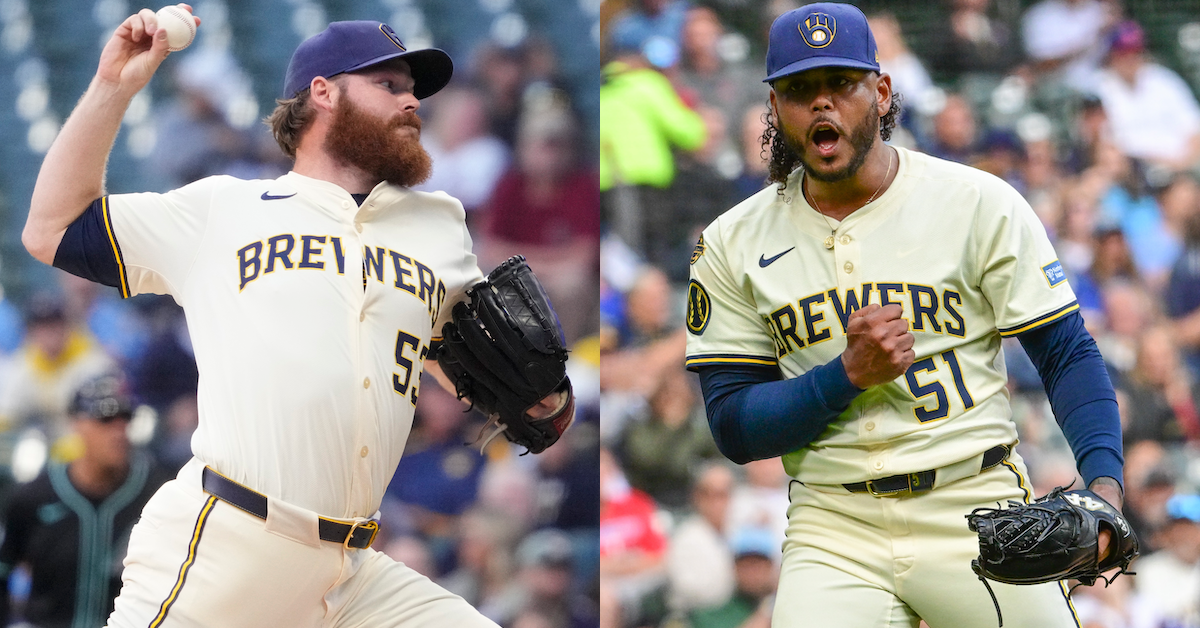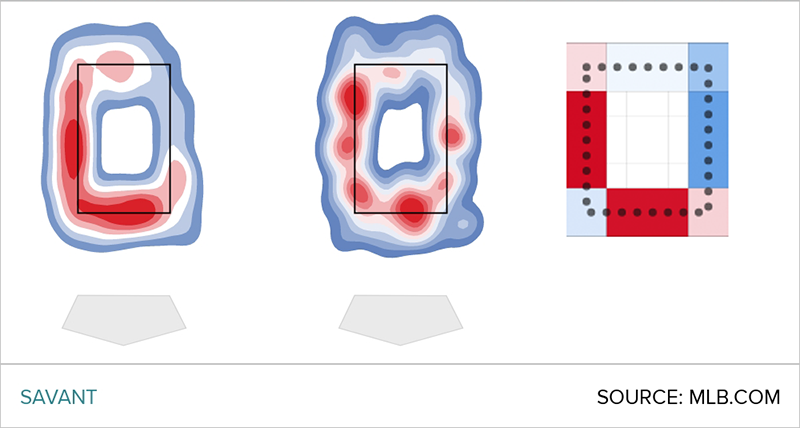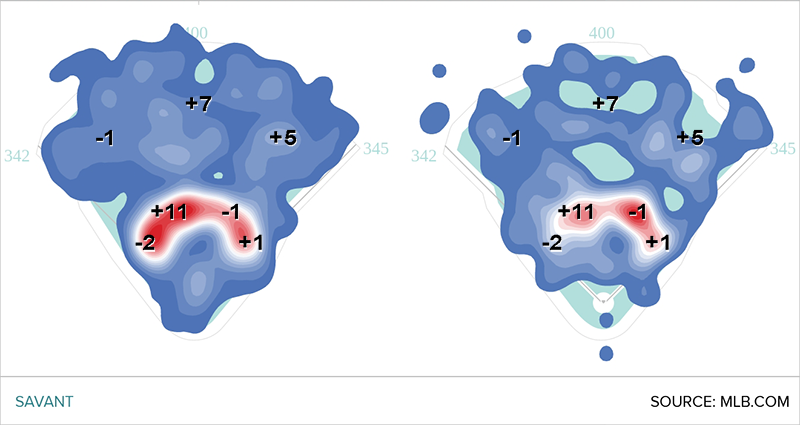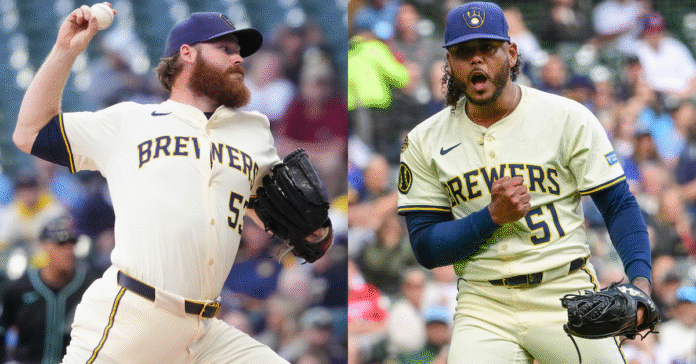
Freddy Peralta is having arguably the best season of his glorious eight-year profession. The correct-hander has ridden a career-best 2.69 ERA to a career-high 16 wins. Nonetheless, I used the phrase arguably for a purpose. Peralta’s 3.64 FIP is simply the fourth better of his profession, and his 3.93 xFIP is tied with 2024 for his fifth greatest. There’s a niche of 0.95 runs per 9 innings between his FIP and his ERA. While you multiply that instances his precise innings whole of 163 2/3, FIP thinks he ought to’ve given up simply over 17 extra earned runs than he really has allowed. None of that is stunning. Pitchers underperform or overperform their peripherals on a regular basis. The fascinating factor is that Statcast says that no pitcher has benefitted as a lot from the protection behind him as Peralta. When he’s has been on the mound, the Brewers protection has been value slightly below 14 fielding runs. It’s neither this straightforward or this clean-cut, however it’s straightforward to mix these two numbers and make an inference: Protection can clarify greater than 80% of the distinction between Peralta’s FIP and ERA.
On the opposite finish of the spectrum is Peralta’s teammate Brandon Woodruff, who returned from shoulder surgical procedure in July and has gone 6-2 over 11 begins and 59 2/3 innings. He’s posted a 3.32 ERA, 3.26 FIP, and three.40 xFIP. In different phrases, FIP thinks Woodruff has gotten precisely what he’s deserved. Nonetheless, Woodruff’s xERA is a scant 2.27. While you mix all these numbers, it means Statcast thinks a number of batted balls that ought to have resulted in outs as a substitute fell in for non-homer base hits. The distinction is a bit over six runs. Coincidentally or not, Statcast says the Milwaukee protection has been at its worst behind Woodruff, costing him slightly below 5 runs, as soon as once more nearly 80% of the hole between an ERA estimator and his precise ERA.
That’s why we’re speaking about Peralta and Woodruff. No two teammates have a much bigger hole between the fielding run worth of the protection behind them. It’s practically an 18-run hole! It’s jarring. With 26 FRV, Statcast thinks the Brewers have the fourth-best crew protection within the recreation, however in some way none of that brilliance has been shining on Woodruff. We’re going to make use of Statcast knowledge to interrupt down, as greatest we will, the explanations behind it. Hopefully, the comparability will present the varied methods a crew can present defensive worth. Let’s begin with the catching numbers.
Catcher Protection
| Pitcher | Pitches Taken | Framing | Throwing | Blocking | Whole FRV |
|---|---|---|---|---|---|
| Freddy Peralta | 1,529 | 4.6 | -0.7 | 1.1 | 5.0 |
| Brandon Woodruff | 444 | -0.1 | -0.3 | 0.0 | -0.5 |
Brewers catchers have been only a bit under common with Woodruff on the mound. There’s nothing significantly notable there. When Peralta has been on the mound, nonetheless, they’ve been at their greatest. He’s gotten a ton of assist in the framing and blocking departments. Why has Peralta gotten a lot framing assist? Let’s begin with who’s doing the catching. The primary column exhibits how every catcher’s framing has graded out this season. The following two columns present the proportion of every pitcher’s takes (that’s, pitches the place the umpire has needed to both name a ball or a strike) they’ve caught.
Peralta has gotten to throw to William Contreras greater than Woodruff, and Contreras is the one catcher on the crew with good framing numbers.
Subsequent, we have to word that Contreras was doing a greater job of framing earlier within the season, when Woodruff was nonetheless recovering from his surgical procedure. Contreras was value six framing runs from March via July, however in August and September, he’s been value unfavourable three. Any variety of components may very well be at play right here. It’s an extended season. He may simply be a bit nicked up. He may very well be drained from the daunting activity of catching Jacob Misiorowski’s scattershot 103-mph fastballs. Regardless of the purpose, Woodruff wasn’t round when Contreras was doing his greatest framing.
The second issue is that the areas of the plate the place Contreras is strongest line up a bit higher with Peralta’s pitch areas. The visible under exhibits three warmth maps. The one on the left exhibits pitch areas when Peralta throws the ball within the shadow zone – the world inside one baseball’s width of the sting of the plate, the place catcher framing occurs. The one within the center exhibits Woodruff’s areas, and the one on the suitable exhibits Contreras’ strengths as a framer this season.

Woodruff and Peralta are fairly related, lacking most incessantly on the backside of the zone and to their arm facet. These two spots are additionally the place Contreras is at his greatest. Nonetheless, you’ll discover that when Woodruff is on the sting of the plate to the arm facet, he tends to overlook close to the nook, both excessive or low, the place Contreras isn’t as nice and the place strikes are more durable to return by anyway. Lastly, Woodruff additionally tends to overlook on the sting to his glove facet too, the spot the place Contreras is at his absolute worst.
I’m positive there are different components at play right here, and all these variations are delicate — Peralta has thrown to Contreras extra, and he acquired to pitch to Contreras earlier within the season when the catcher was on his recreation from a framing perspective; Peralta has additionally hit the perimeters of the zone in areas the place Contreras tends to be a greater framer — however while you put all of them collectively, you’ll be able to see how Peralta may find yourself with a big benefit. Now let’s get into the balls in play.
Infield and Outfield Protection
| Pitcher | Non-HR BIP | FRV | Vary | Arm | DP |
|---|---|---|---|---|---|
| Freddy Peralta | 397 | 7.7 | 6.1 | 0.8 | 0.8 |
| Brandon Woodruff | 140 | -4.3 | -3.6 | -0.1 | -0.6 |
In each single class, Peralta has acquired assist from his protection, whereas Woodruff has been let down. We will get much more granular, although, which is all the time one thing you want listening to while you’re already 1,000 phrases into an article. Let’s begin with batted-ball tendencies. This season, the Brewers have graded out as constructive defensively at first base, shortstop, heart discipline, and proper discipline. They’ve graded out negatively at second base, third base, and left discipline. Now check out the 2 pitchers’ balls in play. As soon as once more, Peralta is on the left and Woodruff is on the suitable.

As you’ll be able to see, Peralta throws extra pitches which can be hit to the spots the place the Milwaukee protection is the very best. His grounders go to the left facet of the infield, the place the protection has been a lot better. He’s induced extra balls to heart and fewer to left. Thus far, 39.2% of Woodruff’s balls in play have gone to second, third, and left, in comparison with 35.9% for Peralta. It appears like a small distinction and it’s, understanding to roughly half a batted ball per begin. However as we’ve seen so many instances, these small components begin to add up. As soon as once more, the date compounds them additional. Right here’s how the Brewers infield and outfield have graded out by month.
Infield and Outfield Protection by Month
| Mar/Apr | Might | Jun | Jul | Aug | Sep/Oct |
|---|---|---|---|---|---|
| -6 | 8 | 11 | 6 | 5 | -3 |
That is one more space the place Woodruff missed a lot of the good instances. After an unpleasant begin in April, the Brewers had been at their greatest in Might, June, and July. They had been value 17 runs earlier than Woodruff debuted on July 6, and so they’ve been value simply 4 since. The most important distinction has come within the outfield. Milwaukee outfielders put up 12 FRV earlier than Woodruff’s season debut, however only one after it. That’ll occur while you lose Jackson Chourio to a hamstring harm and Garrett Mitchell to a shoulder harm. Peralta spent way more time pitching in entrance of these glorious defenders, whereas Woodruff has spent extra time pitching in entrance of Isaac Collins and Blake Perkins, whose numbers have been worse. As you’ll be able to see, the one place the place Woodruff has seen higher protection is heart discipline, and it’s by a whopping 0.19 runs.
Positional Breakdown
| Place | Peralta | Woodruff | Distinction |
|---|---|---|---|
| 1B | 1.6 | -1.5 | 3.1 |
| 2B | 0.0 | -0.5 | 0.5 |
| 3B | 0.4 | 0.3 | 0.2 |
| SS | 3.1 | 0.2 | 2.9 |
| LF | 1.5 | -1.6 | 3.2 |
| CF | -0.4 | -0.2 | -0.2 |
| RF | 1.4 | -0.9 | 2.3 |
The most important variations have come at first base, left discipline, and shortstop. Joey Ortiz and Andruw Monasterio have cut up time at shortstop for each pitchers, and it’s not as if the pair has been dangerous when Woodruff is on the mound. They simply haven’t had as many probabilities to indicate off their expertise. Woodruff has allowed 17 balls to shortstop, and 16 of them have resulted in outs. Joey Ortiz did get one ball caught in his glove for a second, turning a would-be double play right into a fielder’s selection. The one single got here off the bat of Vladimir Guerrero Jr., and it was kind of a freaky play.
No one’s guilty right here (besides perhaps the third baseman), however this gigantic hop price Woodruff a run. The larger distinction, although, is that he hasn’t been on the mound for any performs like these:
All these nice performs by Ortiz got here with Peralta on the mound. There’s absolutely some luck concerned, however largely it’s that he’s pitched extra innings and induced extra balls to brief, giving Ortiz’s expertise a greater likelihood to shine.
Woodruff has solely pitched with Andrew Vaughn at first base, whereas Peralta has pitched with Vaughn, Rhys Hoskins, and a pair instances Jake Bauers at first. None of those gamers is an unbelievable defender, however Hoskins has graded out higher than Vaughn this season. Nonetheless, Woodruff has solely allowed 12 batted balls to first base all season. Ten of them had been both popouts or groundouts. Listed here are the 2 performs that went awry:
That is some critical dangerous luck, for each Vaughn and Woodruff. That first play is a bullet that left Ian Happ’s bat at 106.9 mph. Vaughn is taking part in shallow as a result of he’s holding the runner on first base. He dives and deflects the ball behind the second baseman, who finally ends up sprinting within the flawed path fully. Sure, a greater defender fields that ball cleanly and begins a 3-6-3 double play, however it’s definitely not an egregious misplay.
The second play is even unluckier. Vaughn fields a routine grounder and turns to second to start out a double play, however each the second basemen and shortstop are masking the bag. Vaughn’s throw was perhaps a bit off-line, however it’s arduous guilty him on this scenario, and it’s removed from sure that even an ideal throw would’ve been caught after the center infielders bonked into one another. So this goes down as a throwing error, however it’s just about all the protection letting Woodruff down.
That’s what occurs while you don’t play as a lot. Small samples provide you with unbalanced outcomes. Although the Brewers have been worse defensively later within the season, the handful of dangerous performs weighs extra closely.
We may have achieved this evaluation with any two pitchers. Each pitcher has totally different tendencies, which can both assist them or harm them relying on the catcher, the protection behind them, and the ballpark they’re pitching in. It’s enjoyable to see a pair that diverges so extensively on the identical crew (although I’m positive Woodruff would beg to vary). It helps as an example simply how a lot can change merely due to timing, accidents, deadline offers, batted-ball tendencies, and pure happenstance. Baseball is a sophisticated recreation, and issues are likely to stability out over time, besides after they don’t.
